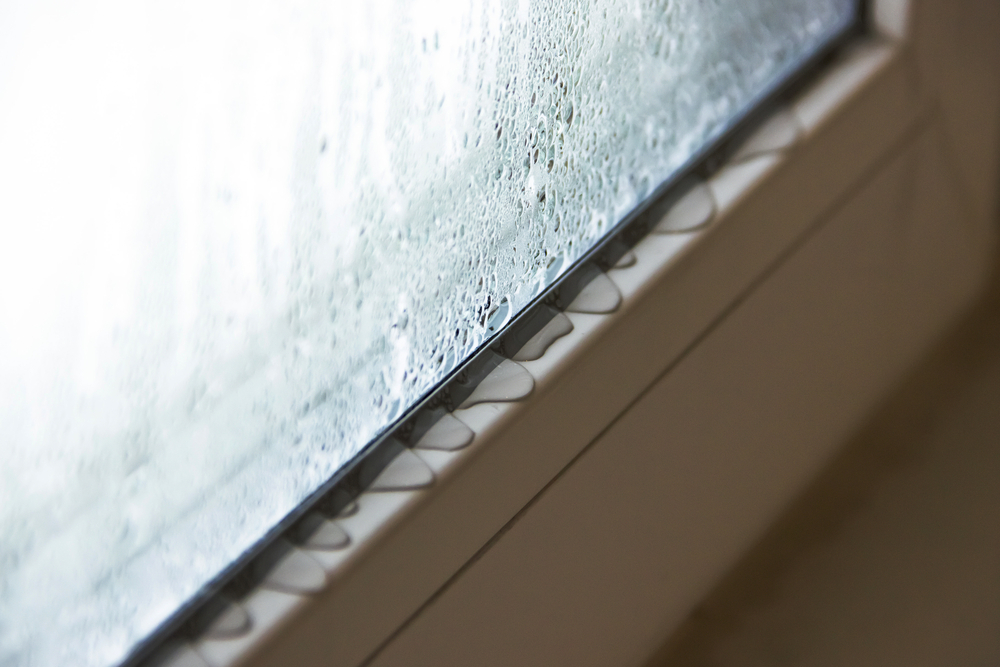
A common complaint when it comes to winter camping is condensation in RV campers. RV condensation can develop very quickly in cold weather, and we aren’t just talking about some moisture on the windows. Little water droplets will develop on the walls and along any metal inside the rig too. Condensation can actually damage the walls, floors, furniture, and cabinetry in your RV by causing mold to form, wood to rot, and metal to rust or become corroded.
Because it can cause so many problems, camper condensation is not something you want to mess around with. Here’s how to keep moisture out of your RV in winter.
This post contains affiliate links. RVshare may receive compensation if you make a purchase after clicking on a product link.
1. Warm Things Up
Although it is the warm air meeting the cold air that creates condensation, if you raise the indoor temperatures enough, you can actually curb condensation production. This is because raising the indoor temperature should also raise the temperature of the cold surfaces in the rig, such as glass. This should slow RV window condensation significantly, but probably won’t stop it completely.
2. Invest in a Dehumidifier
As mentioned before, removing moisture from the air will also help those needing to know how to keep condensation off RV windows and walls. This is why you should keep an RV dehumidifier in your rig in the winter. This simple appliance will reduce humidity significantly.
3. Put Your Vent Fans to Use
You can help out your dehumidifier for RV use by also putting your vent fans to use. You should have a vent above your stove, as well as one or two on the ceiling of your RV. Make a point of opening them and running the fans a couple times a day when things start to feel humid.
4. Open a Window
Alternatively, or even in addition to opening the vents, you could crack a window. This lets moisture escape and allows the drier outdoor air in. Some people even find that a small RV window fan helps to get the air moving. You’ll only need to run it for a few minutes two or three times a day to help dry things out.
5. Avoid Hanging Things to Dry Indoors
Obviously, if you’re trying to remove moisture from the air, you won’t want to undo all of your work by adding to the humidity. Therefore, it’s wise to avoid hanging wet things to dry inside the rig. Go ahead and put the laundry room dryers to use during the cold months, and hang towels to dry outside if at all possible.
6. Skip the Propane Furnace
Another important tip for those wondering how to stop condensation on windows in RV campers is to turn off the RV furnace. No, we aren’t suggesting you go cold—only that you use electric space heaters instead. Propane heaters emit lots of moisture. Meanwhile, electric heaters will keep things nice and dry.
Important note: If you are relying on a heated underbelly to keep your water system from freezing, this is not the tip for you. The RV furnace must be running for the underbelly to stay warm. That said, you can use a small space heater under the rig to keep things warm. Using this in addition to RV skirting and/or tank heaters might be enough to prevent issues.
7. Change the Way You Cook
Pots and pans on the stove release steam into the air. Keeping your stovetop cooking covered is somewhat helpful. However, avoiding using the stove is even better.
Instead of the stovetop, consider one of the following options:
- RV oven — The oven is a much better alternative to the RV stove. That said, even the propane oven can produce some moisture. Therefore, if you have a convection oven, we’d recommend choosing that option.
- Instant Pot — An Instant Pot is a fabulous electric appliance to have in an RV for a variety of reasons. You can use this gadget to reduce the amount of moisture in your RV by using it for cooking instead of doing so on a stovetop, and then releasing the pressure outdoors.
- Outdoor cooking — Speaking of the outdoors, taking all of your cooking outside will remove the issue of releasing steam into the air entirely.
8. Use the Bathhouse
If removing moisture from the air is how to stop condensation in an RV, you obviously don’t want to take a hot shower and put extra moisture into the air. In fact, showering is probably the number one cause of moisture buildup in the air within a motorhome or trailer.
Therefore, you will definitely want to skip the shower in your rig and head to the campground bathhouse any time one is available.
9. Cover the Windows
Most RV condensation in winter is going to be found on the windows. As mentioned earlier, this is because the windows are cold from the chilly outdoor air. You can help fix condensation on the inside of windows by covering the windows with a special window insulation film.
10. Think about the Cabinets
Finally, because moisture tends to build up in small enclosed spaces, it’s a good idea to keep cabinet doors open as much as possible when the weather is cold. This will keep air circulating and help avoid mold growth caused by trapped condensation. Pop them open when you go to bed at night so they aren’t in your way while moving about the rig. We also recommend tossing some DampRid in each of your cabinets. This will help absorb some of the moisture that might gather during the day.
How Do I Get Rid of RV Condensation During Storage?
Our number one tip for how to stop condensation in a camper while it’s in storage is an RV moisture absorber product such as the aforementioned DampRid. Products of this type offer RV moisture control by absorbing any moisture that does collect in your RV.
Typically, if we’re going to see condensation in camper trailers or motorhomes while in storage, we’ll find it in the cabinets and closets. Therefore, we recommend placing the DampRid in the cabinets and other enclosed spaces, as well as leaving the cabinet doors open.
Fortunately, condensation is much easier to prevent when an RV is not in use, because normal moisture-producing activities (such as cooking and showering) aren’t taking place in the rig. Additionally, since no heaters will be running, the inside air temperature should be similar to the temperature outside, making condensation even less likely.
Still, it never hurts to take an extra step to ensure you don’t return to an excess of moisture in your RV.

Condensation on Windows in RV
If you are having issues with condensation in your RV, we recommend focusing first on the windows of the rig to make sure you’ve done everything you can to prevent moisture buildup.
Earlier we talked about using a window film to prevent condensation inside window panes in your rig. This is definitely a good bet. Some campers choose to put Reflectix in their windows instead, as this reduces condensation and offers even more insulation.
Another option? Look into double pane RV windows. Double pane windows are great for reducing condensation and providing better insulation in an RV. Unfortunately, they do come with some downsides. Some of the cons of double pane RV windows include their weight—double the panes means double the weight—and their cost, which is quite high and hard to justify if you are only in your RV for a few weeks a year.
What Causes Condensation Inside an RV?
Let’s start by finding the root of the problem. What causes condensation in motorhomes and travel trailers? In short, the answer is moisture and temperature.
When the warm air in your cozy RV comes into contact with colder surfaces—such as windows, metal window frames, or even walls—the moisture in that air is released and small water droplets are formed.
You could prevent condensation from forming by cooling the inside of the RV to match the outdoor temperature, but then you’d be uncomfortably cold. Technically, warming the outside air would also get rid of the condensation, but unless you can control the weather or have the freedom to head south for the winter, this isn’t really an option either.
Therefore, the best way to prevent condensation in RV rigs is by removing the moisture from the air.
RV Condensation FAQs
Still have questions about RV condensation and how to keep it in check? We’re here with the information you need. These are some of the most frequently asked questions on the subject and our answers to each.
How do I stop my motorhome from getting damp in the winter?
Unfortunately, you can’t completely stop moisture from accumulating in your RV in the winter. That said, there certainly are ways to reduce the amount of moisture in the air in your RV so you can remove condensation from the windows and walls and keep your carpets and furniture from feeling damp.
As mentioned above, an RV dehumidifier is the very best thing for this, but the other tips above will also help with that damp feeling, so you can be totally comfortable in your rig even when it’s cold outside.
How do I make my RV winter-proof?
We mentioned that RVing in winter is totally doable, and it is, but there are some things you need to know first. Preventing condensation from taking over is just the first step to making your RV winter-proof.
Other steps you should take include insulating the windows, adding insulation to the walls, adding a skirt to the bottom of your rig, using tank heaters and a space heater to ensure your water system doesn’t freeze, adding a heated hose to your setup, and wrapping your sewer hose with heat tape to prevent freezing.
Don’t plan to be in your RV during the winter? In that case, adding some DampRid to the cabinets like we suggested above, winterizing the water system, removing the batteries and placing them on a battery maintainer, and making sure you take steps to prevent pests are all good ways to get your rig ready for winter.
How do you absorb moisture in an RV?
To absorb moisture in your RV, you will take the same step you’d take to remove condensation or a damp feeling: run a dehumidifier all winter long. Placing DampRid in various places throughout the rig will also help absorb moisture, and using the other tips above will ensure you aren’t creating extra moisture in the RV unnecessarily.
How do I insulate the inside of my RV?
In the section about winter-proofing your RV, we mentioned insulating the windows and walls of your rig, as well as adding RV skirting to your setup. These are all good ways to improve upon RV insulation and keep your RV toasty warm for the winter months.
To insulate your camper windows, consider adding the aforementioned plastic film to each one. You can also use Reflectix panels cut to fit in each window, but many find that this method creates a very dark little home-on-wheels. As far as walls go, consider hanging blankets or tapestries on the walls to retain heat. You might also hang something in front of the door (where a lot of heat tends to escape) and put covers on the vents and skylights.
An RV skirt will help keep cold air from blowing under the RV. It’ll also prevent the water system from freezing. There are all sorts of RV skirting options, including inflatable RV skirts, vinyl skirting, and DIY skirts made of hay bales, wood, or whatever else you can find.
RV Condensation in Winter
Yes, RV condensation in winter can be a real issue. Fortunately, there are plenty of ways to get rid of the moisture and nip the problem in the bud. By using the ten tips above, you should be able to continue to camp throughout the winter without many condensation issues.
Looking for more winter camping tips? We have all the info you need including tips on keeping warm and this one on packing for winter.
Don’t want the hassle of owning a camper and thus worrying about RV condensation? Rent one with RVshare!

